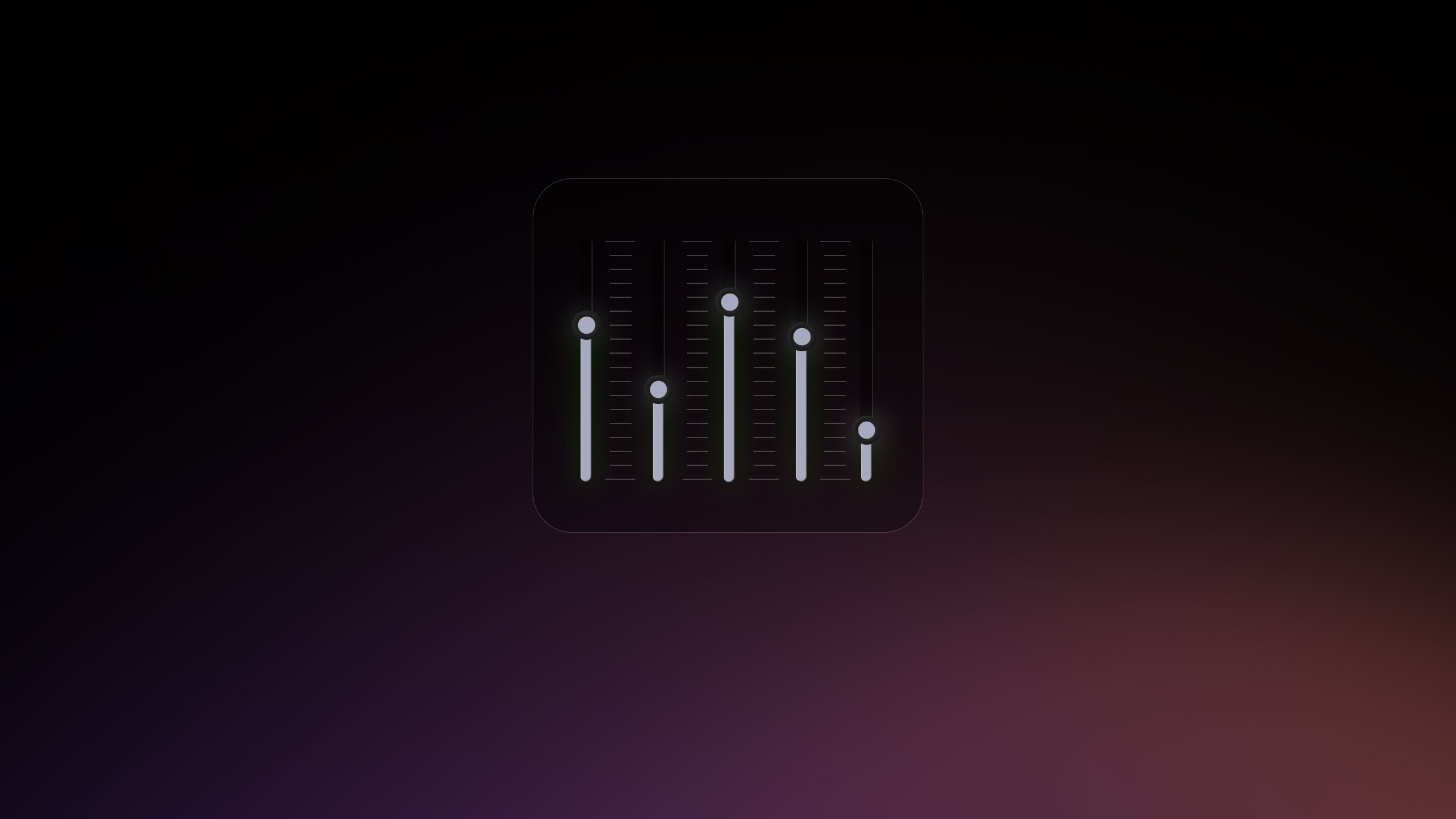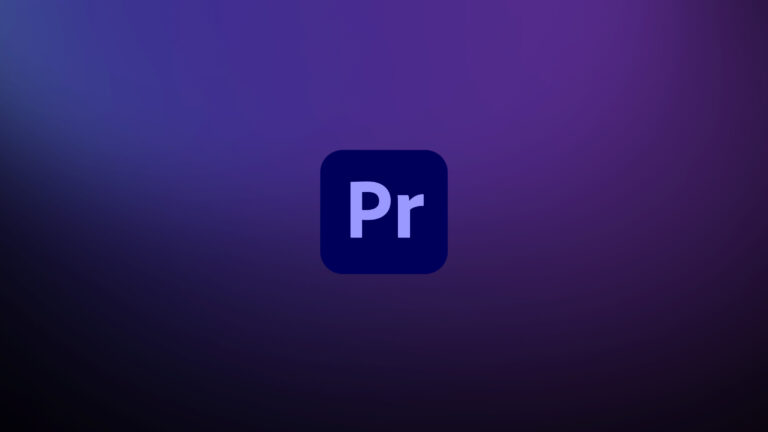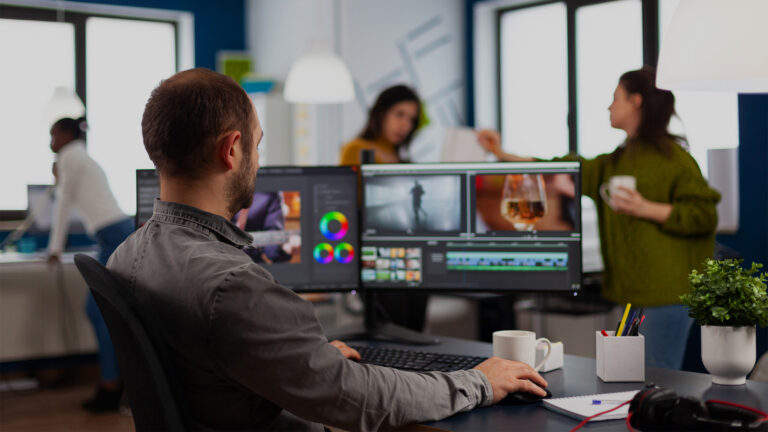It used to be that your graphics card—or specifically the processor on your graphics card called the GPU—only pushed pixels to your screen. But these days it can be used in conjunction with your computer’s CPU to increase performance for a wide range of applications. In fact, GPUs specialize in tasks like video encoding, effects processing, and 3D modeling, and AI-based processes like Auto Reframe, often performing them significantly faster than your CPU can. So it’s no surprise that the GPU has become a valuable asset for creative professionals.
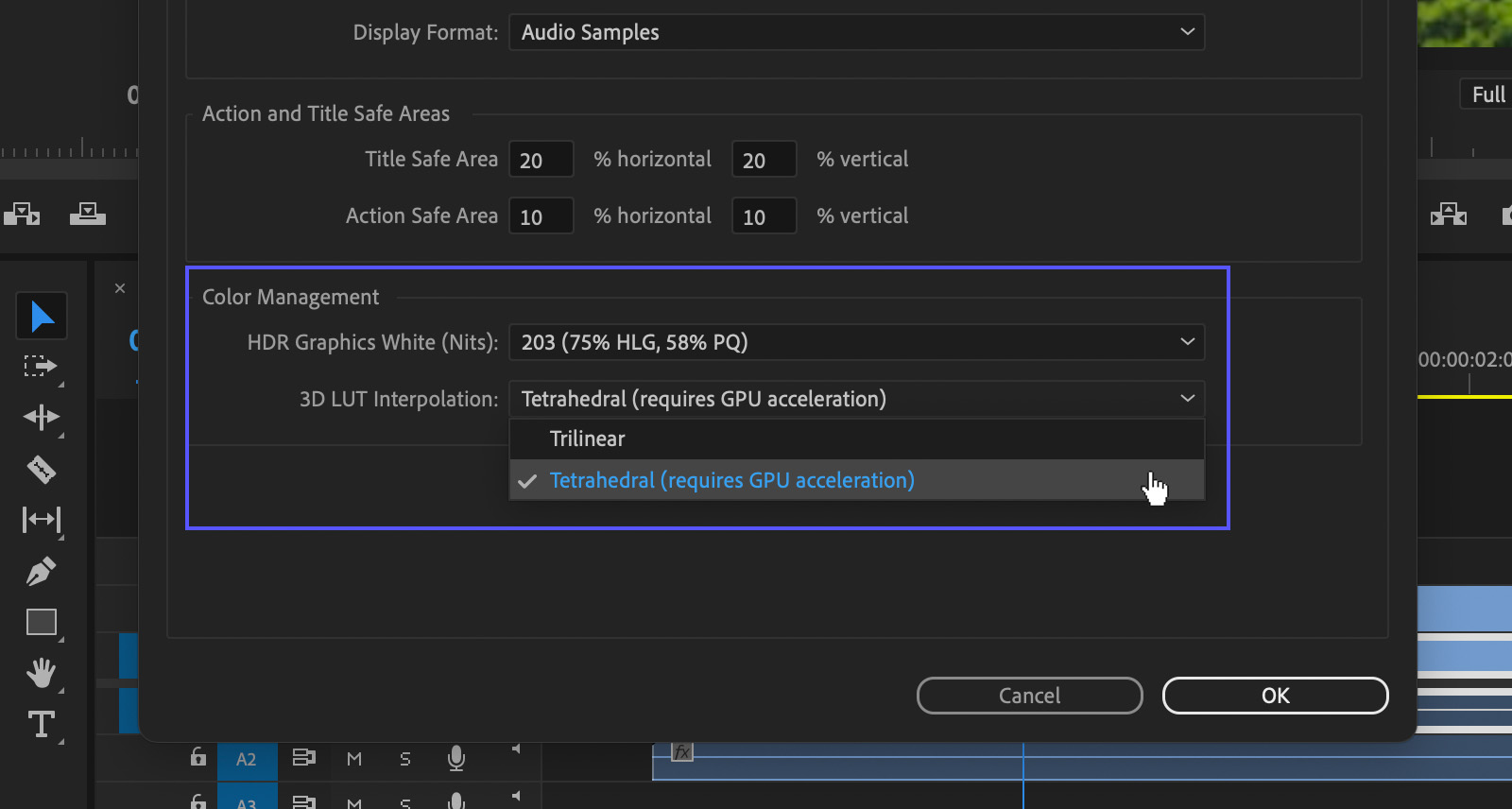
GPUs from NVIDIA are easily the most popular, with the manufacturer claiming over 80 percent of the discrete GPU market in Q3 last year. And they all come with the NVIDIA Control panel software, which lets you manually adjust how your graphics card works.
Most people just leave the NVIDIA Control Panel settings at their defaults—and that’s fine—but if you’re thinking about tweaking things, you should know what those defaults are actually doing before you start pressing buttons.
Contents
The usual caveats
The super-helpful NVIDIA people who answered some of my highly detailed technological questions want to make sure that you, the reader, understand that NVIDIA driver and performance engineers have spent considerable time and investment, both internally and in conjunction with software vendors, to optimize application performance through driver code and application settings. The goal is to provide the best out-of-the-box user experience possible.
You change these settings at your own risk.
What’s done on which GPU?
It should be noted that some systems have an integrated GPU—either on the mainboard or built into the CPU itself—and it’s not always easy to tell when this integrated GPU is doing something instead of your NVIDIA GPU. So if you’re monitoring the activity of your GPU and have two GPUs in your system, always double-check that you’re looking at the right one.
In Premiere Pro, the GPU can assist with decoding and encoding certain video codecs, calculate effects like color grading and LUTs. It can also scale, reposition, rotate and stabilize footage, deinterlace, and so on.
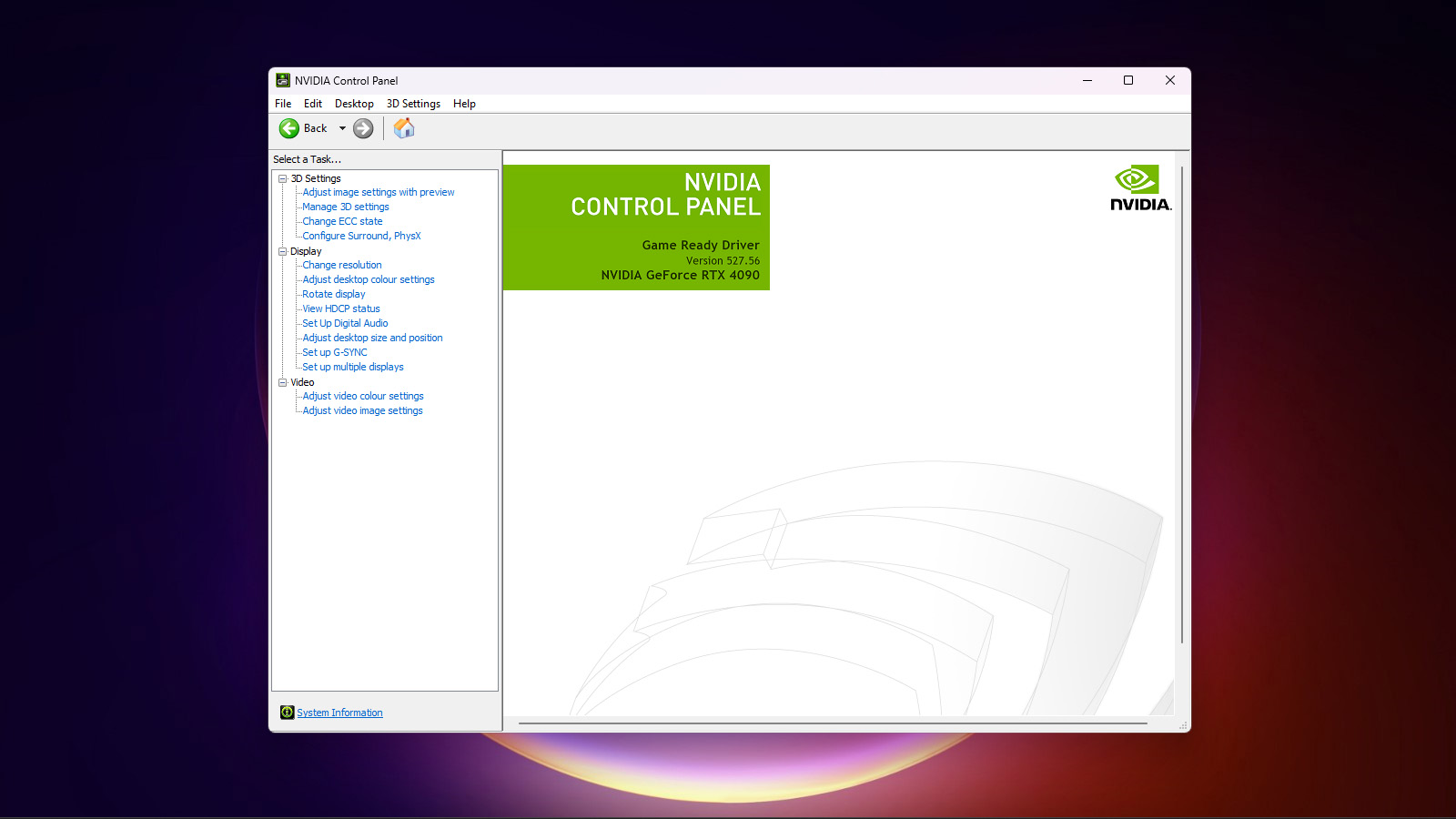
A very common complaint is that “Premiere Pro almost doesn’t use the GPU on my system at all.” But this might be because you’re not giving it any significant work to do. Also, Premiere Pro may understand that sending the frames between the CPU and the GPU may take more time than to do it all on one of them. Shuffling data between the GPU memory and the CPU memory can be slow. It’s one of the reasons why Apple made the M1/M2 processors with shared CPU and GPU memory.
In addition to rendering frames in Premiere Pro or other software, the NVIDIA GPU is probably also pushing pixels to your display. If you don’t see the Display and Colors/Image settings, it’s because no monitor is being fed by the NVIDIA GPU. Which indicates that your system is using its integrated GPU instead. In many cases, you can change your system’s BIOS settings to use the NVIDIA GPU as the primary GPU. Just bear in mind that changing your BIOS settings isn’t something a novice can safely do.
Where to get the drivers
You can get the drivers via an OS update, via the system vendor or graphics card manufacturer, or directly from NVIDIA. For the latter, you’ll find the latest drivers on NVIDIA’s driver download page.
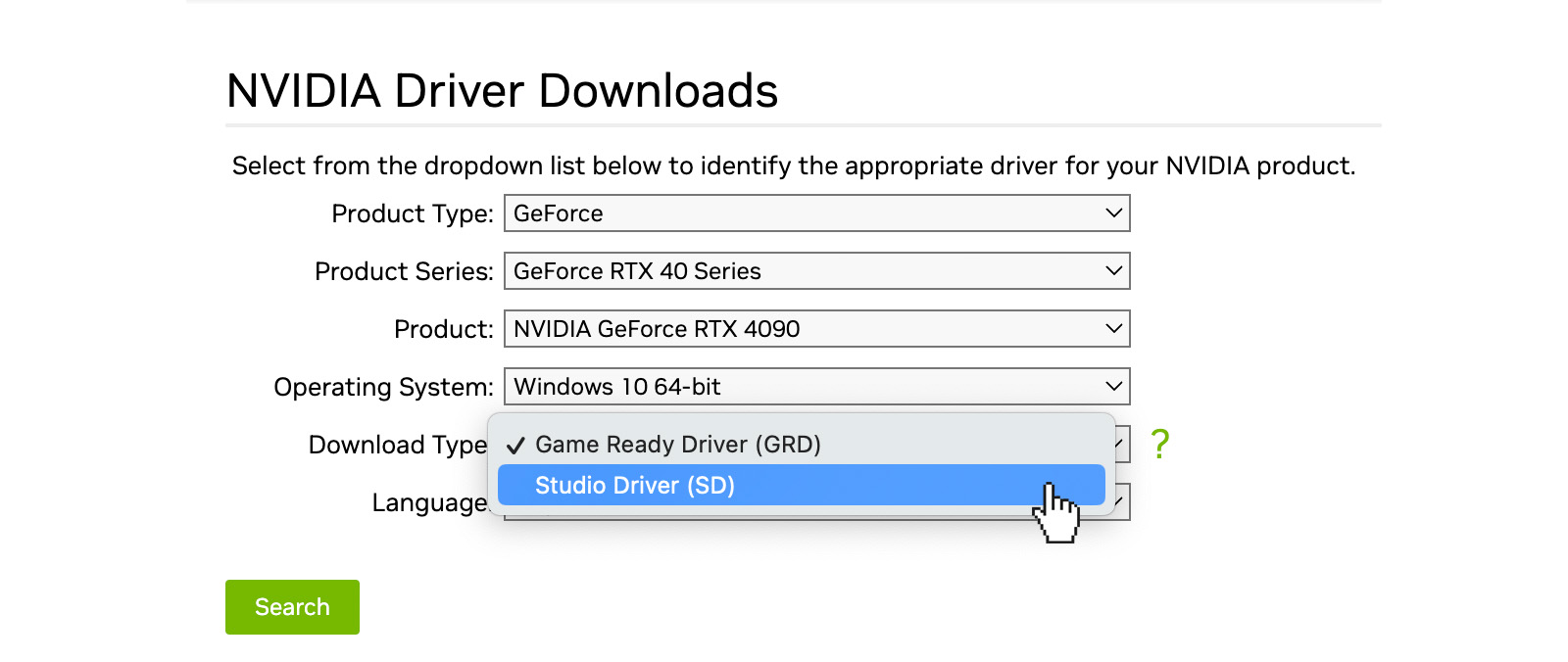
If you’re unsure what GPU you have, right-click the Windows desktop and select NVIDIA Control Panel, then click the System Information link in the bottom left-hand corner. (If you’re using Windows 11, you may need to reveal the NVIDIA Control Panel option by right-clicking and selecting Show more options.) You’ll also find the same info in the Help menu in the NVIDIA Control Panel. Help > System Information.
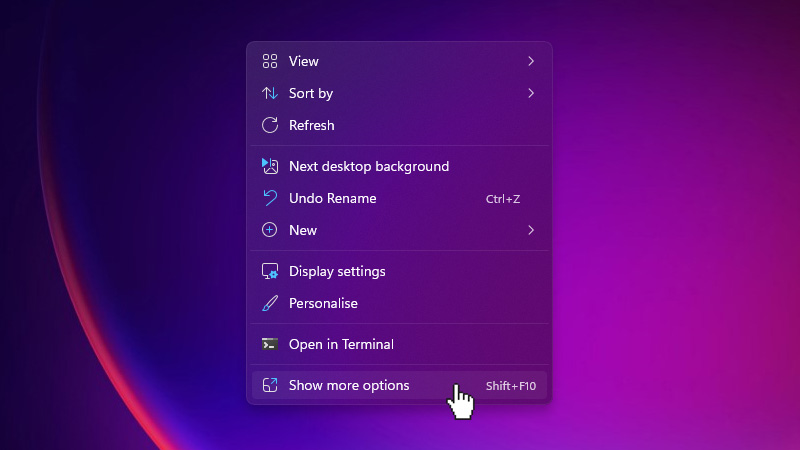
On the download page for the selected driver (once you hit the Search button) shows provides the Release Highlights, Supported Products, and the Additional Information tab—which has links to Release Notes and to the NVIDIA Control Panel User’s Guide (PDF documents) where you can read the fine details.
Most people only download the drivers. But it’s worth digging into the Release Highlights first because it has info on new features, fixed issues, and known issues—which can help you decide whether to update or remain on your currently installed driver. The Supported Products tab shouldn’t be applicable if you used the search function correctly. (And remember that you should also be keeping your video editing software up to date as well as your drivers.)

If you have an RTX- or Quadro GPU, it’s also worth noting that NVIDIA offers the RTX Experience app, which will notify you of any updates when they become available. (Login required.)
Gaming drivers or Studio drivers?
For video editing, the choice should be obvious: you want the Studio drivers, not the Gaming drivers or the New Feature drivers. But what’s the difference?
Production Branch/Studio drivers are designed and tested to provide long-term stability and availability, making them ideal for video professionals, and for users who require application and hardware certification from ISVs and OEMs respectively. Because of this, they have a relatively slow launch cycle.
For video editing, the choice should be obvious: you want the Studio drivers.
New Feature Branch (NFB) drivers give you the ability to try new features made available outside the launch cycle of longer-lived Production Branch drivers. NFB drivers are tested for workstation environments and are only recommended for early adopter users who need specific features mentioned in the release highlights or release notes. Hopefully, that does not include you.
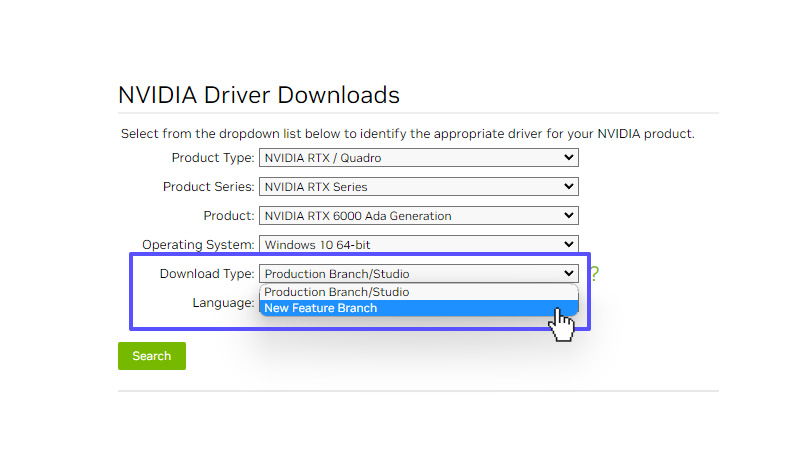
Note: You may not see the Production Branch/Studio or New Feature Branch options in the Download Type as these choices are dependent on your GPU.
For the most stable and fully supported driver use the Studio drivers downloadable from NVIDIA driver download page.
What can you do with the NVIDIA Control Panel?
To get started, right-click the desktop and then select NVIDIA Control Panel (on Windows 11, right-click and invoke the old-style menus with Show more options.)
In addition to setting up basic display configurations such as display resolution, refresh rate, and multiple display use, you can do the following things in the NVIDIA Control Panel:
- Tune your 3D settings with real-time preview to maximize performance or image quality.
- Customize how 3D applications work in your system.
- Adjust your screen colors and contrast.
- Set custom timings.
- Control video image settings.
- Change your HDTV format.
- Control special workstation features such as Frame Synchronization.
Note: The NVIDIA Control Panel can be viewed with a desktop DPI scaling set to a maximum of 250%. Setting the DPI higher than 250% may result in some content getting cut off from view.
General settings, menus and navigation
Some of the settings in the NVIDIA Control Panel can be accessed in different places. Clicking the System Information button in the Home pane for example, takes you to the same place as clicking Help > System Information.
The Menu bar
The File and Edit menus don’t do much for us, but the Desktop menu and the 3D Settings menu have some settings that you may want to understand.
Should you enable Video Editing mode?
Video Editing Mode (in the Desktop menu, if it’s available for your driver/GPU combination) sounds great for us video editors. The user manual says, “Select this option to improve the video playback experience for some video editing applications.” But that’s pretty vague and generates a few questions, like what does ‘improved video playback experience’ actually mean? And is Premiere Pro among the ‘some’ in ‘some video editing applications’?
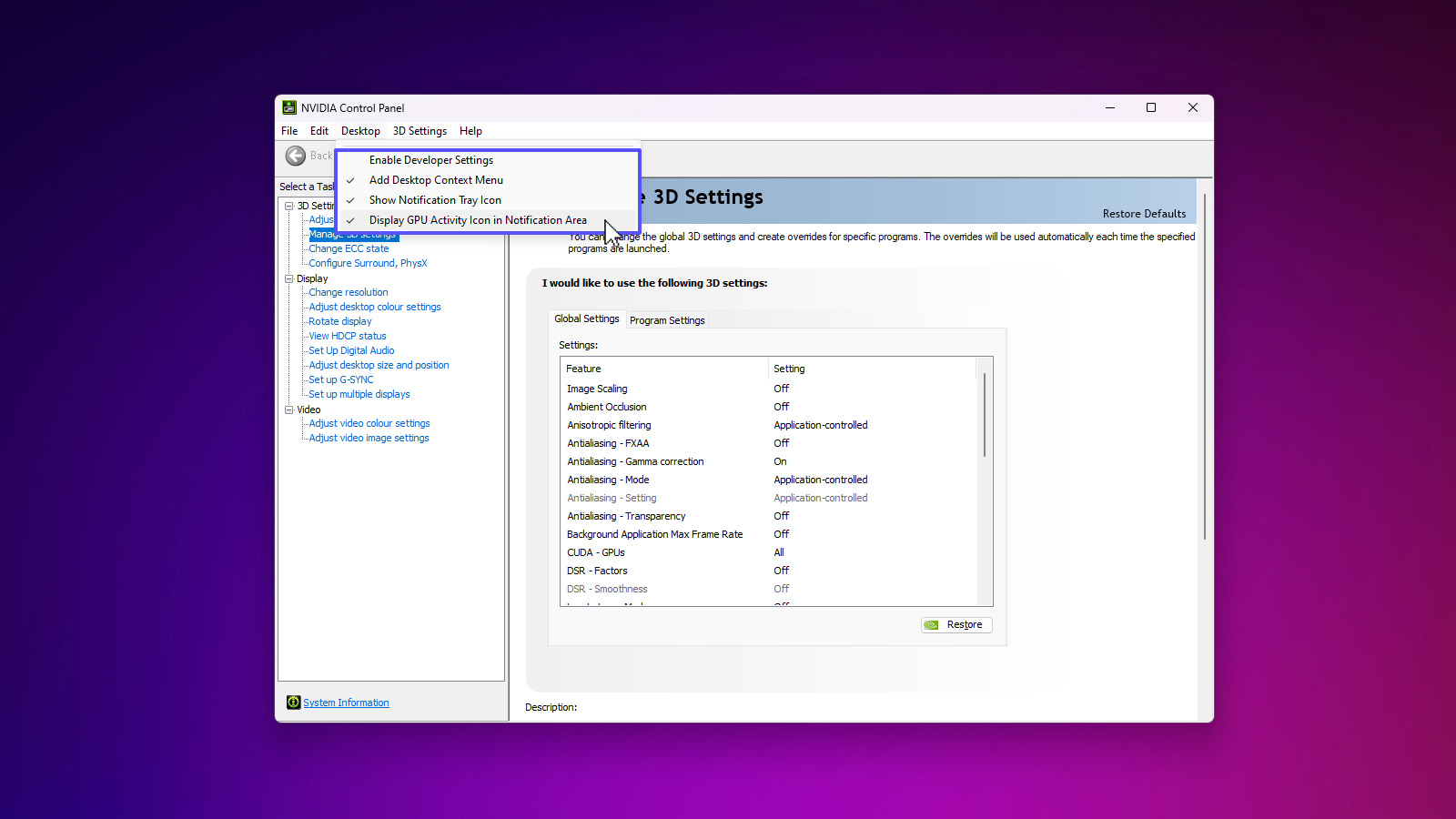
This is a legacy feature. In Windows 7, this enabled tear-free video playback. Windows 10 and later does not require the use of this feature for tear-free video playback, so you will not see any benefit from enabling Video Editing Mode.
The Help menu
The Help menu offers direct links to Nvidia Support pages, as well as an NVIDIA Control Panel Help link (though, on my Norwegian Windows 11 system, this directs to non-existent page).
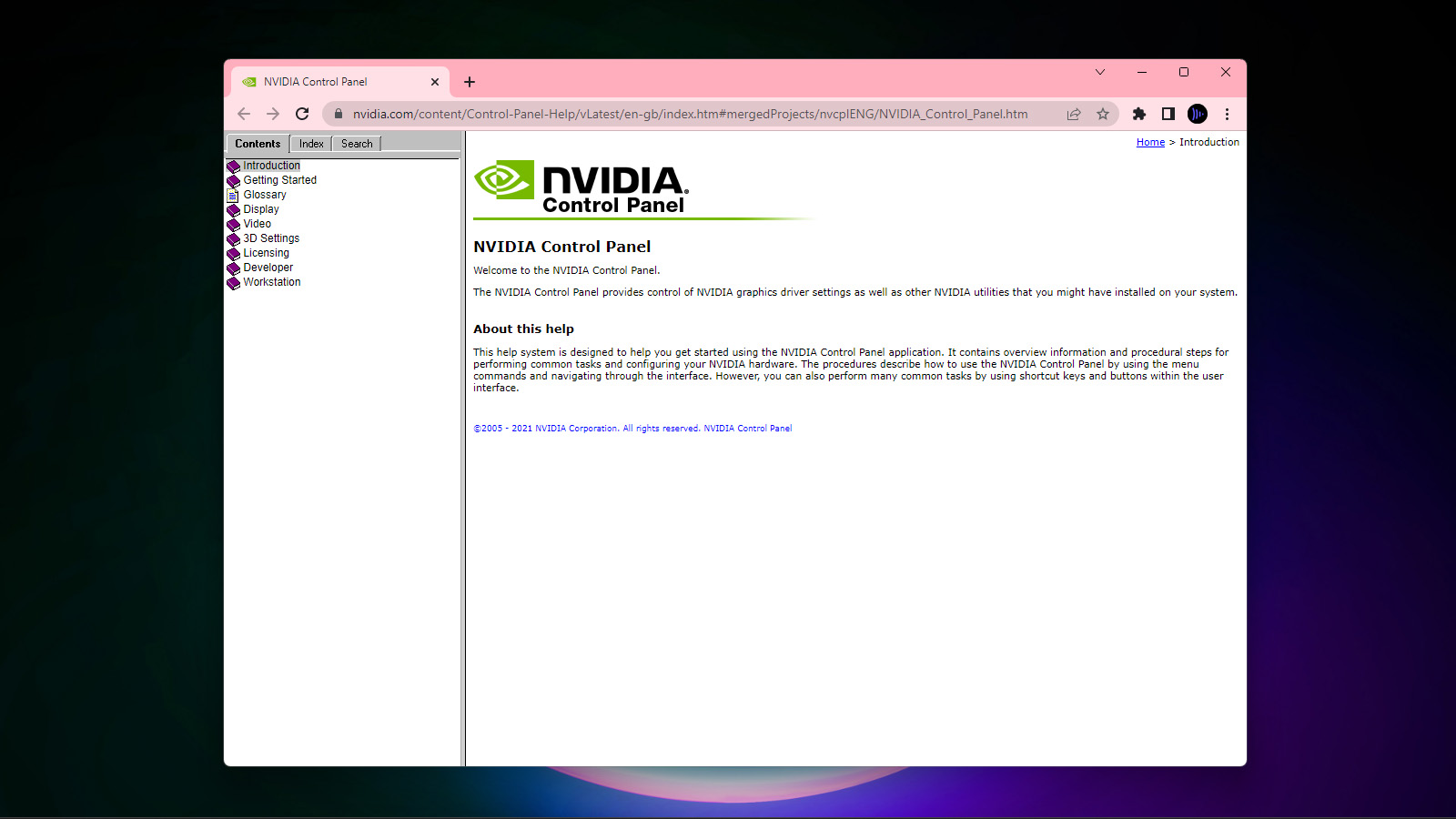
The most useful entry in the Help menu is System Information, which will show you the name of your GPU, the currently installed driver version, etc.
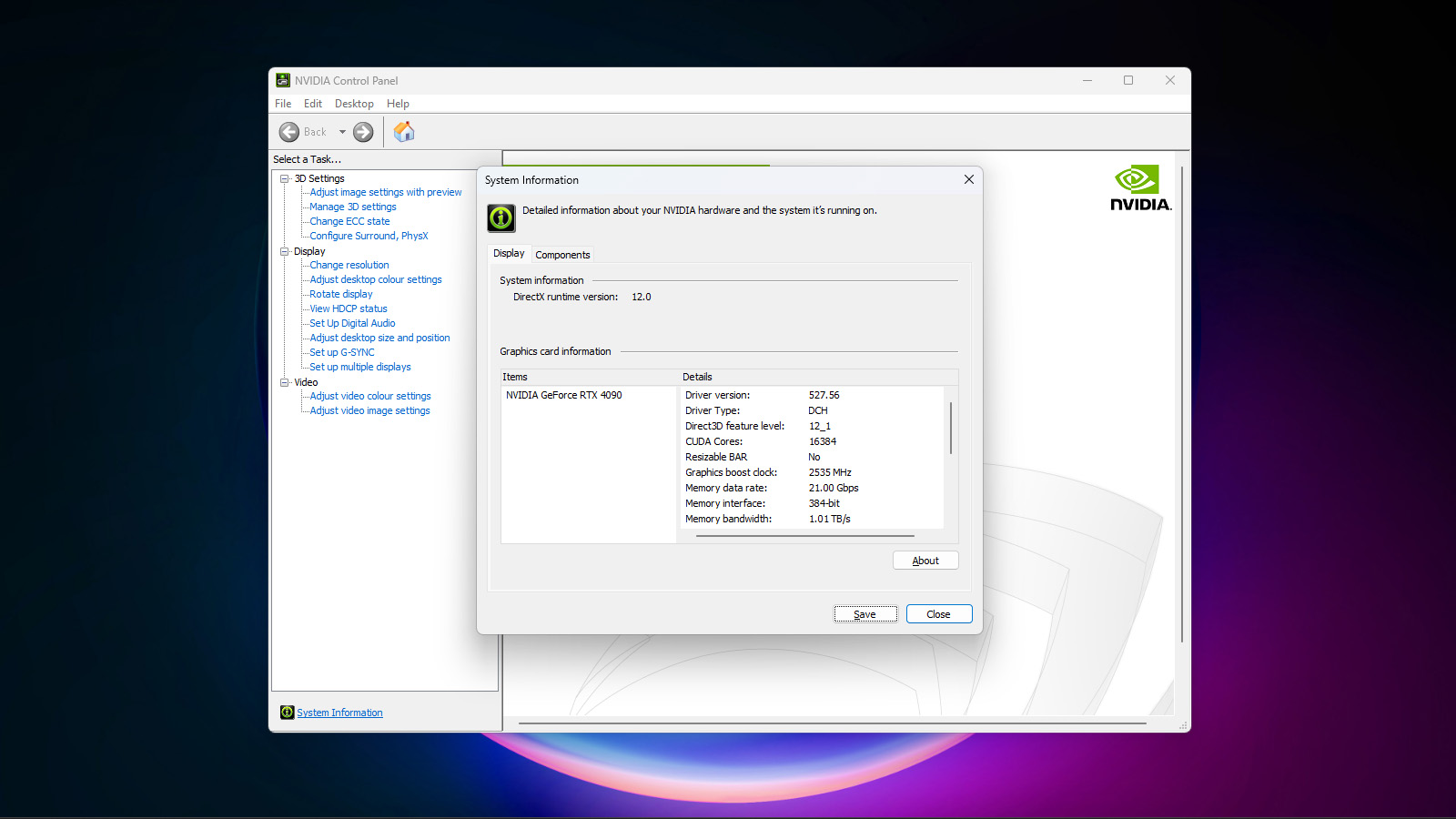
The Task pane
The Task pane shows all the settings you can adjust to choose how the NVIDIA Control Panel affects apps and monitors. Clicking on a task reveals its settings in the main task area.
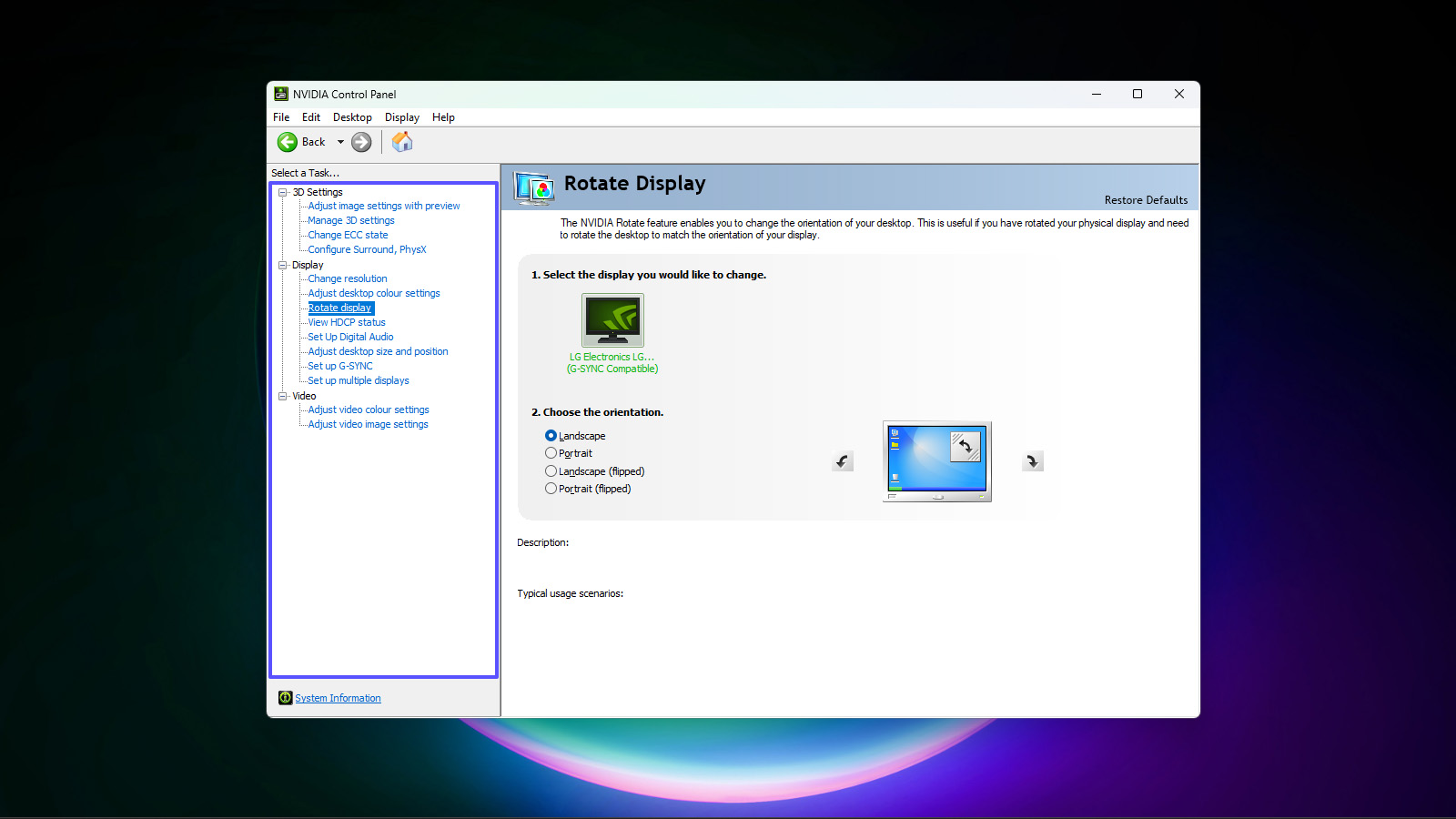
Workstation settings
This is where you can see the true resolutions and refresh rates of your monitors, what ports they’re connected to, and also set up a single desktop on multiple displays via Mosaic.
The Video menu
This is where you can choose Color Settings and Video Settings for displays connected to the NVIDIA GPU. It’s recommended that you leave both at the default “Use the Video Player Setting.”
If you really need to, you can override settings for Color, Gamma, Dynamic Range, Noise Reduction, Edge Enhancement, and Deinterlacing.
The Full (0-255) setting for Dynamic Range in the Video Color Settings only applies to HDMI ports (even though it doesn’t say it explicitly).
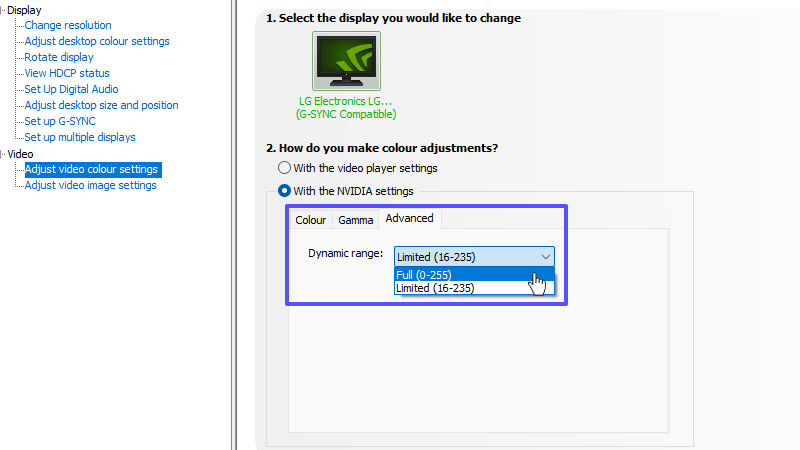
Settings for Premiere Pro, After Effects and others
Finally—what you came here for! The slightly improperly named Manage 3D Settings task controls a huge number of settings both globally, and for individual apps—including apps like Premiere Pro that’s not a 3D app.
Global Settings
You may recall that a few years ago, it was recommended that you choose the “3D app – Visual Simulation” setting under Manage 3D Settings > Global Settings for best performance in Premiere Pro. That’s no longer the case, and you should leave Global Presets in the default Base Profile because the application is now automatically optimized.
NVIDIA says: “The profiles available under the Global presets options were created in conjunction with developers and software vendors to perform specific tests and/or run the NVIDIA GPU in certain debugging environments. Oftentimes, the global profiles available in the presets are used to set the GPU in a particular state that complements software designed for developer testing or troubleshooting.”
So this is clearly not something that the average user of editing software should fiddle with!
You may be tempted to adjust the settings for Vertical Sync, but it’s recommended to leave it at the default, which is Application Controlled. This is important since a windowed application like your NLE is displayed through the operating system’s desktop compositor. The NVIDIA driver doesn’t control the desktop compositor so forcing Vertical Sync may have an unintended impact on the application behavior and potentially performance.
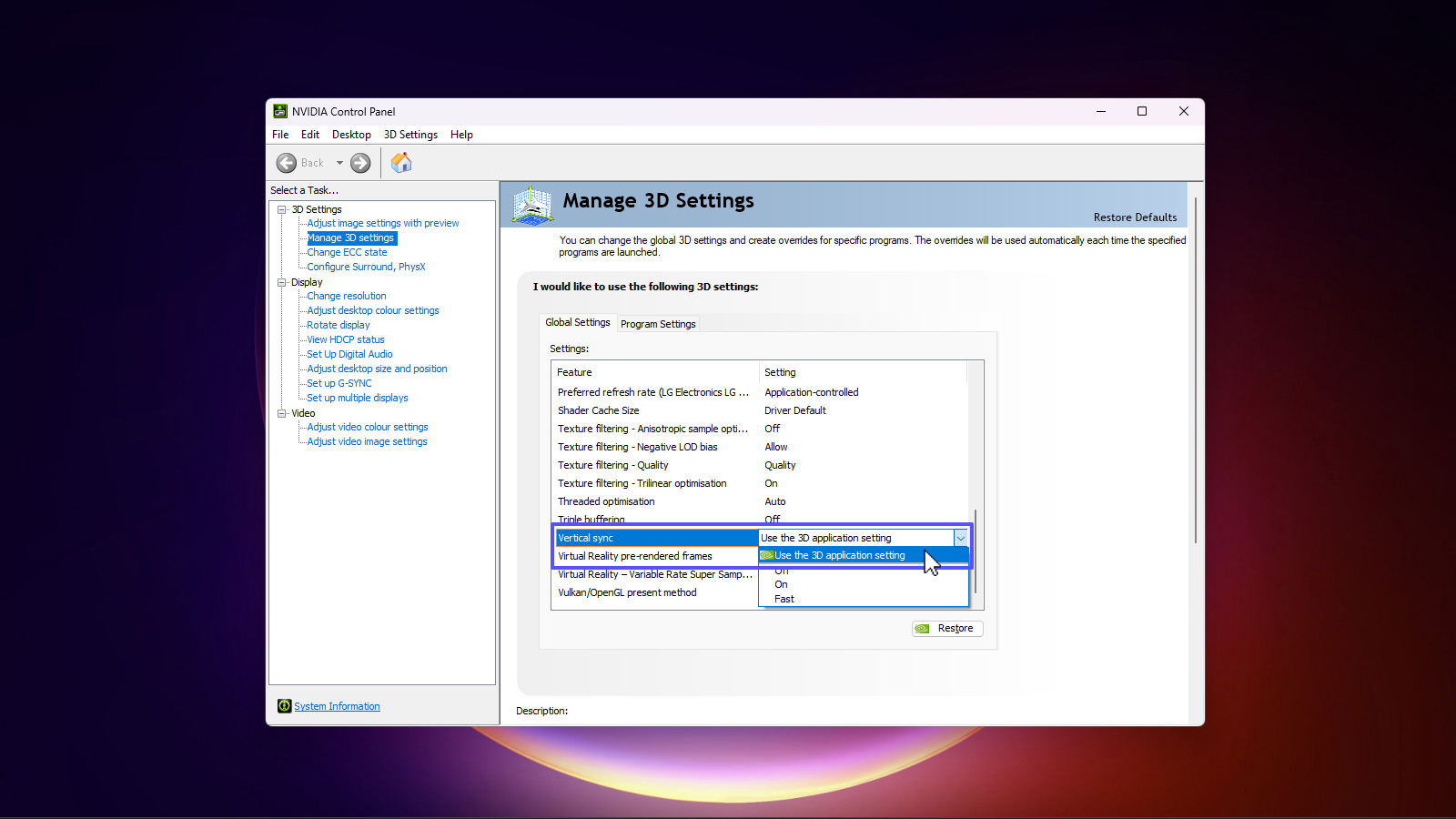
NVIDIA says: “The Monitor doesn’t have to be fixed at a refresh rate. In some ways, using variable rate refresh (VRR) may be advantageous for video editing, since a VRR can emulate any refresh rate. For example, if you are viewing a 24Hz video on a VRR display it may be presented at exactly 24Hz because the video play back software ensures every frame is shown at the correct refresh rate. However, if you were viewing 24Hz on a 75Hz fixed refresh monitor the video playback software will have a hard time showing 24Hz exactly.”
The Global Presets options are a workstation feature, available only to users of NVIDIA RTX or Quadro GPUs. These are advanced settings that should generally not be adjusted because of the potential for unintended consequences. Global settings, by their very nature, affect all applications, unless otherwise specified. Making settings with one particular application in mind may negatively impact other applications where those settings are sub-optimal.
NVIDIA’s advice is: “Users should leave Global Presets in the default Base Profile. In this profile, program settings for individual applications will take priority and Base Profile settings will only take effect in the absence of application preferences or if directed by the application.”
Manage 3D Settings > Global Settings > Preferred Graphics Processor should be set to “Auto” for best results, especially for users on laptop systems. Using the NVIDIA GPU for all applications, whether they need GPU acceleration or not, may drain the laptop battery more quickly than desired.
Program Settings
The Manage 3D Settings task also has specific Program Settings. Again, NVIDIA advises against modifying Program Settings. The driver settings (some of which are visible to users, some are internal) for each program were derived through tight collaboration between the NVIDIA and Adobe engineering teams.
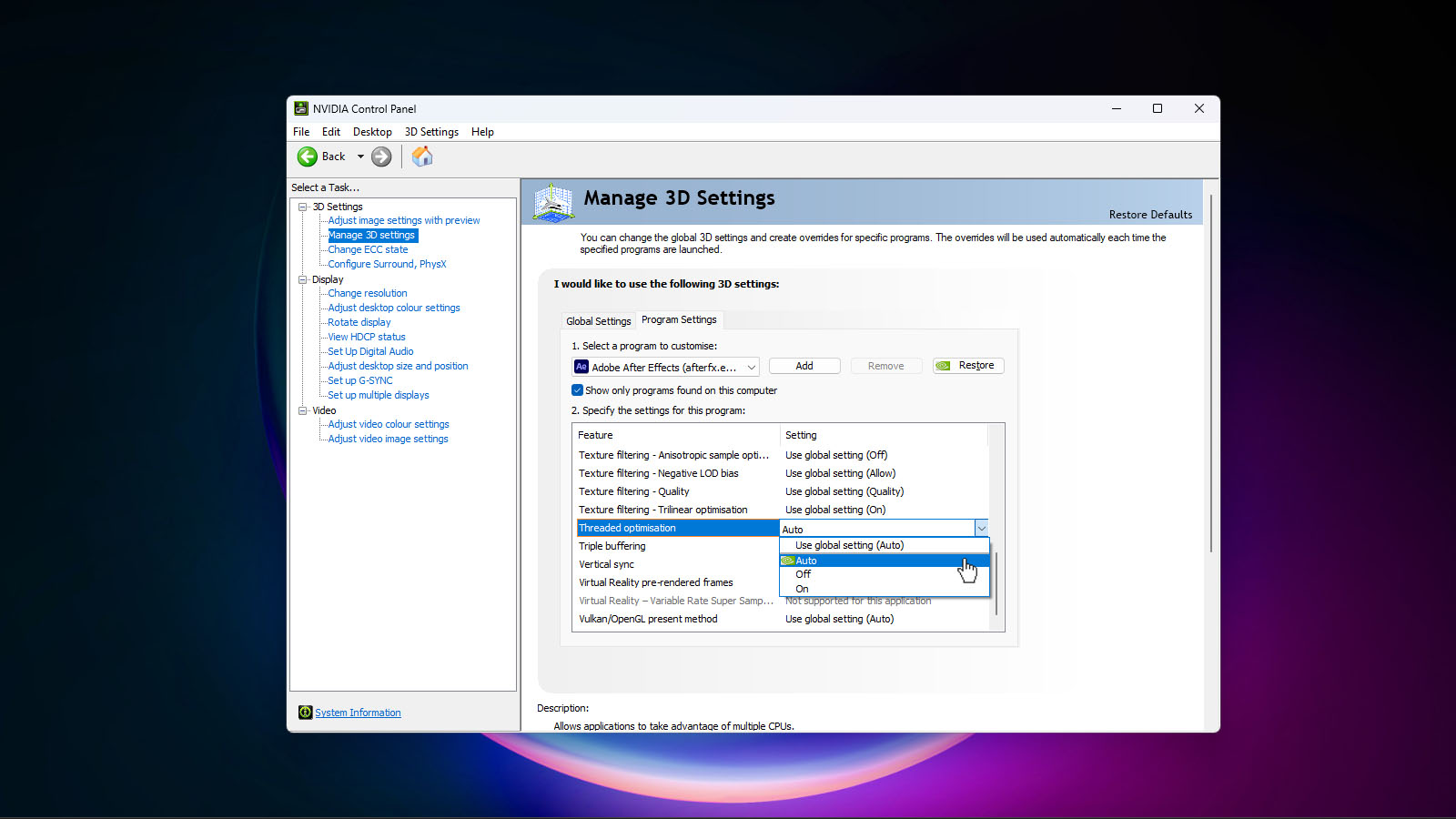
NVIDIA says: “Deviating from these values is only recommended for those who truly understand the impact of these advanced settings and are using them for development and/or troubleshooting purposes. For best results, users should leave the default settings for Premiere Pro and After Effects.”
Power consumption is less of a concern for desktop systems or laptops that are plugged into their power supplies. In these cases, you can use your discretion for whether to set the NVIDIA GPU to always be chosen—although Premiere Pro and After Effects will invoke the NVIDIA GPU in the “Auto” setting wherever GPU acceleration is possible.
PhysX configuration for video editors
Nope. PhysX is mostly for 3D software and games. These settings do not affect NLE software like Premiere Pro.
If you want to know what these settings do, they allow users to select whether the system’s CPU or GPU (or what GPU, if you have more than one) will be used to accelerate PhysX code and libraries.
Settings for monitors
If you have any displays connected to the NVIDIA GPU, you will see the Display tasks. If you don’t see the Display tasks, that means that your monitor isn’t connected to the NVIDIA GPU. In this section, you can change the Screen Resolution and Frame Rate settings, including creating and editing custom resolutions and frame rates. The results rely heavily on your monitor and its capability of showing resolutions and frame rates.
Change resolution
Although the name of the task doesn’t indicate it, this is also where you set some color settings and the refresh rate of the display—two settings that can be very important to video editors.
Since I live in Europe—where most video is shot at 25- or 50 frames per second—making sure that Refresh Rate is set to 50Hz ensures that every frame is shown the same number of times. This lets me see fluid, non-stuttering video while editing.
Note that some displays only have the capability to show non-native frame rates when you lower the resolution. For example, my monitor can only show 5120 x 2160px at 60Hz.
If I change the resolution to 1920 x 1080px, and choose to Perform Scaling on the Display (which we’ll get to in the next section) I can choose between 60, 59.97, 50, 24, and 23.98 Hz. The driver somewhat inaccurately calls these 60, 59, 50, 24, and 23.
I also like to see my video at 10-bit color depth, when available. If the monitor is 10-bit, then the desktop and output color depth should also be 10-bit. Similarly, if the display is High Dynamic Range (HDR) capable then again HDR would be the best choice.

Your monitor’s capabilities are revealed to the system by its driver, allowing your OS and graphics driver to select the best/optimal settings automatically. It’s not a bulletproof process, though. The “Use Default Settings” choice should choose 10-bit when it’s available, but at times, this may not be the case. I do like to check what it’s set to, just so I know. If settings do not match the monitor capabilities, then it’s worth investigating and trying different settings.
Be aware that these settings work in tandem with the UI scaling settings in your OS. Stick to UI scaling percentages that are divisible by 50 to avoid strange problems in the UI in Premiere Pro, After Effects and other apps. So 150, 200, 250, etc. are safe. Percentages like 125 and 175 should be avoided.
Adjust desktop color settings
Be very careful when making adjustments here. I’ve only ever used these to adjust the image on poorly-adjusted projectors in locations where I’m not allowed to touch the projector.
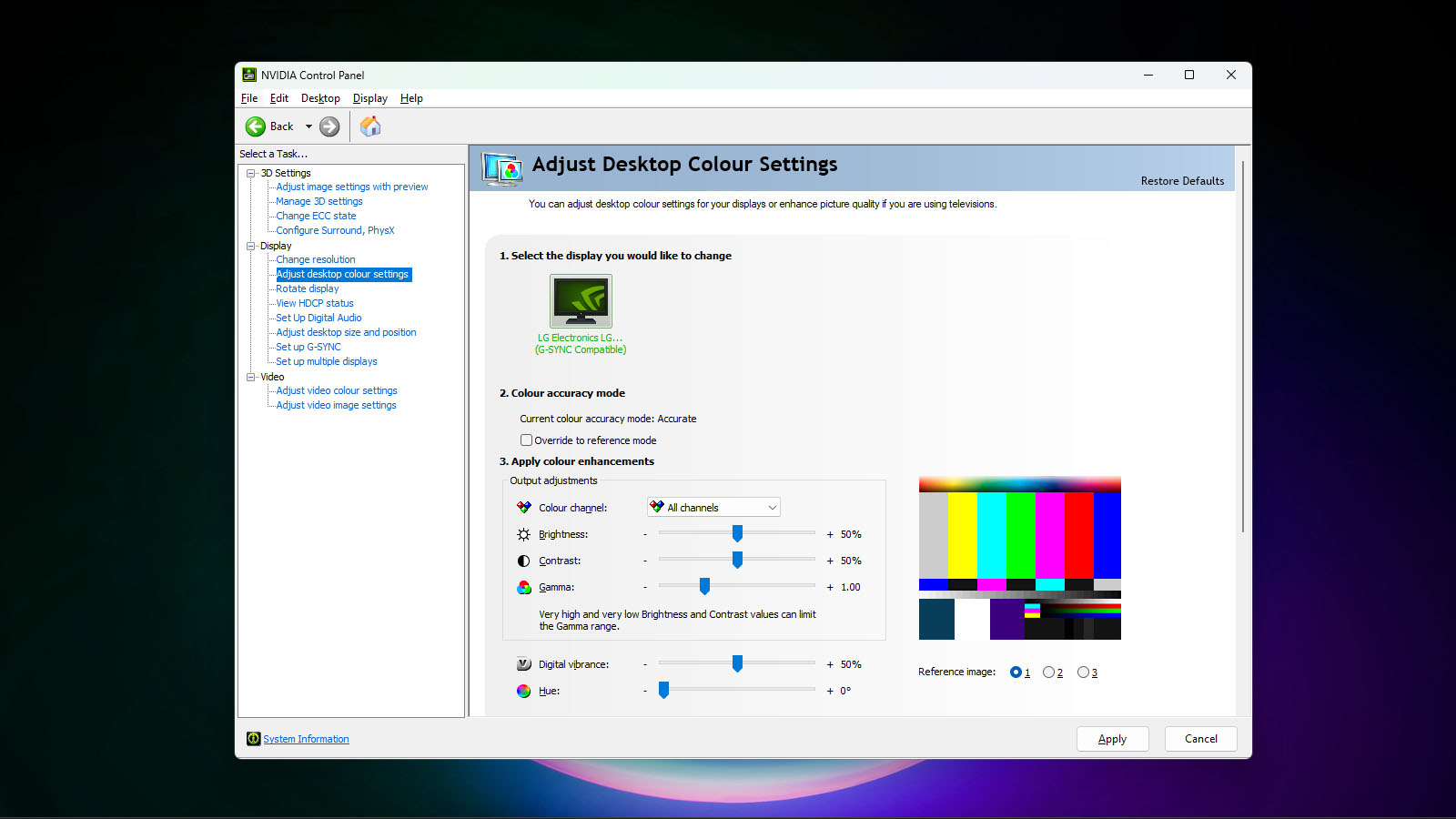
Rotate display
This is where you can manually rotate and flip the image to match the rotation of your monitor—assuming it doesn’t detect its orientation and adjust itself automatically.
View HDCP status
High-Bandwidth Digital Content Protection is a way to protect HD content from being copied. You can’t do anything here. It will just tell you if your system is HDCP-compliant so you can play copy protected DVDs etc. on it.
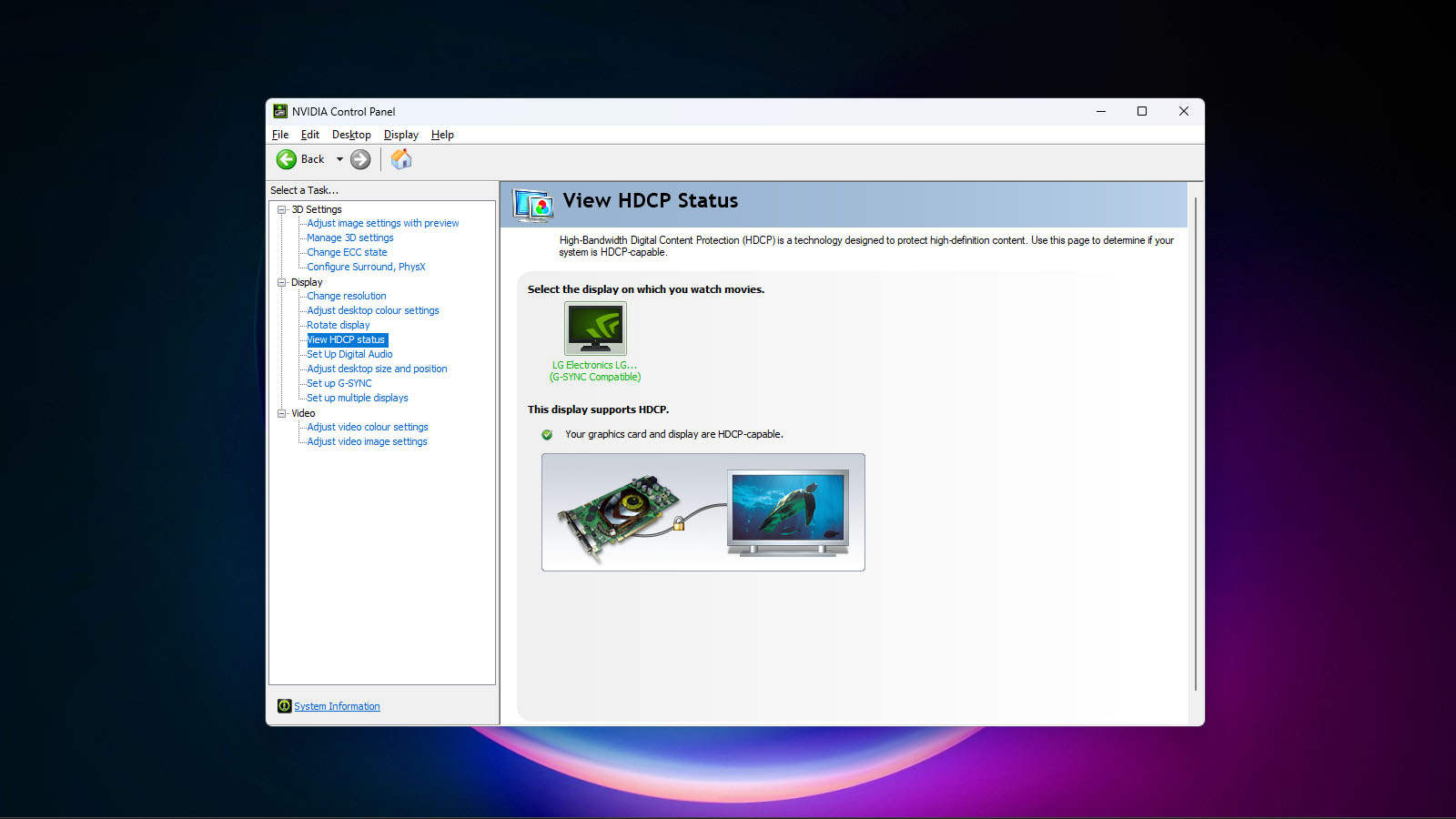
Set up Digital Audio
This shows you what audio devices you have available, and provides a shortcut to the Windows Sound Settings, where you can adjust default sample rates and levels for recording and playback, and turn off any audio “enhancements.” (Recommended.)
Adjust desktop size and position
This is more of a legacy feature these days, but if your connected display overscans, cutting off a small part of the desktop, this is where you can fix it. It’s also where you can change the Display Scaling, which is very useful if you have a high-res monitor, or an ultrawide screen, and need to share your screen through Teams, Zoom etc.
Set up multiple displays
If you have multiple displays connected, this is where you can choose the order etc. Just drag the icons to match your display configuration so that the mouse cursor moves correctly between them, and positioning windows works as expected.
Where to get more information
You can click Help > NVIDIA Control Panel Help to get to the Help system.
Every driver download link also has a link to the Release Notes PDF with the latest information, which you might prefer.

Don’t forget other GPUs
Remember, you may have more than one GPU. If you have issues with the decoding of H.264 and H.265 video, it may not be a problem with the NVIDIA card. If the decoding is done on an integrated Intel GPU, no settings in the NVIDIA Control Panel and no NVIDIA driver versions can fix the problem.
Intel GPUs on Windows
Download the Intel Driver & Support Assistant from here.
AMD GPUs on Windows
Download the AMD Driver Auto-detect tool from the AMD Driver and Support page.
Scroll down to the section named “Auto-Detect and Install Radeon™ Graphics Drivers for Windows©”. Click on the Download button and follow the instructions.
Intel and AMD drivers on macOS
GPU drivers for Apple Macs are included in the macOS system updates and don’t have separate download sites or drivers.

